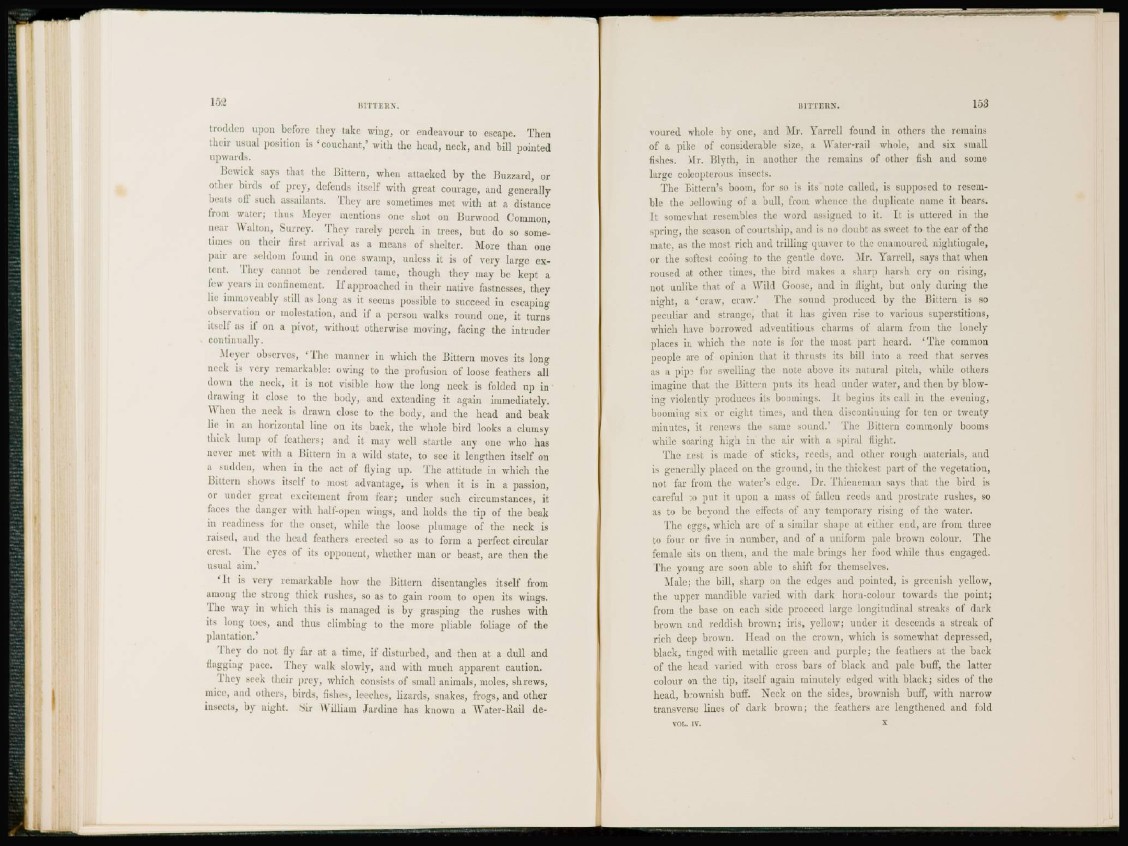
L52 BITTERN.
trodden upon before they take wing, or endeavour to escape. Then
[heir usual position is 'eouchant,' with the head, neck, and bill pointed
upwards.
Ik-wick says that the Bittern, when attacked by the Buzzard, or
other birds of prey, defends itself with great courage, and generally
beats off such assailants. They arc sometimes met with at a distance
from water; thus Meyer mentions one shot on Burwood Common,
near Walton, Surrey. They rarely perch in trees, but do so sometimes
on their first arrival as a means of shelter. More than one
pair are seldom found in one swamp, unless it is of very large extent.
They cannot be rendered tame, though they may be kept a
few years in confinement. If approached in their native fastnesses, they
lie immoveably still as long as it seems possible to succeed in escapingobservation
or molestation, and if a person walks round one, it turus
itself as if on a pivot, without otherwise moving, facing the intruder
continually.
.Meyer observes, ' The manner in which the Bittern moves its long
neck is very remarkable: owing to the profusion of loose feathers all
down the neck, it is not visible how the long neck is folded up in
drawing it close to the body, and extending it again immediately.
When the neck is drawn close to the body, and the head and beak
lie in an horizontal line on its back, the whole bird looks a clumsy
thick lump of feathers; and it may well startle any one who has
never met with a Bittern in a wild state, to see it lengthen itself on
a sudden, when in the act of flying up. The attitude in which the
Bittern shows itself to most advantage, is when it is in a passion,
or under great excitement from fear; under such circumstances, it
faces the danger with half-open wings, and holds the tip of the beak
in readiness for the onset, while the loose plumage of the neck is
raised, and the head feathers erected so as to form a perfect circular
crest. The eyes of its opponent, whether man or beast, are then the
usual aim.'
' I t is very remarkable how the Bittern disentangles itself from
among the strong thick rushes, so as to gain room to open its wings.
The way in which this is managed is by grasping the rushes with
its long toes, and thus climbing to the more pliable foliage of the
plantation.1
They do not fly far at a time, if disturbed, and then at a dull and
flagging pace. They walk slowly, and with much apparent caution.
They seek their prey, which consists of small animals, moles, shrews,
mice, ami others, birds, fishes, leeches, lizards, snakes, frogs, and other
insects, by night. Sir William Jardine has known a Water-Rail de-
BITTERN. 153
voured whole by one, and Mr. Yarrcll found in others the remains
of a pike of considerable size, a Water-rail whole, and six small
fishes. Mr. Blvth, in another the remains of other fish and some
large coleopterous insects.
The Bittern's boom, for so is its note called, is supposed to resemble
the bellowing of a bull, from whence the duplicate name it bears.
It somewhat resembles the word assigned to it. It is uttered in the
spring, the season of courtship, and is no doubt as sweet to the ear of the
mate, as the most rich and trilling quaver to the enamoured nightingale,
or the softest cooing to the gentle dove. Mr. Yarrell, says that when
roused at other times, the bird makes a sharp harsh cry on rising,
not unlike that of a Wild Goose, and iu flight, but only during the
night, a 'craw, craw.' The sound produced by the Bittern is so
peculiar and strange, that it has given rise in various superstitions,
which have borrowed adventitious charms of alarm from the lonely
places in which the note is for the most part heard. 'The common
people arc of opinion that it thrusts its bill into a reed that serves
us a pipe for swelling the note above its natural pitch, while others
imagine that the Bittern puts its head under water, and then b y blowing
violently produces its boomiugs. It begins its call in the evening,
booming six or eight times, and then discontinuing for ten or twenty
minutes, it renews the same sound.' The Bittern commonly booms
while soaring high in the air with a spiral flight.
The nest is made of sticks, reeds, and other rough materials, and
La generally placed on the ground, in the thickest part of the vegetation,
not far from the water's edge. Dr. Thieueman says that the bird is
careful to put it upon a mass of fallen reeds and prostrate rushes, so
as to be beyond the effects of any temporary rising of the water.
The eggs, which are of a similar shape at either end, are from three
to four or five iu number, and of a uniform pale brown colour. The
female sits on them, and the male brings her food while thus engaged.
The young are soon able to shift for themselves.
Male; the bill, sharp on the edges and pointed, is greenish yellow,
the upper mandible varied with dark horn-colour towards the point;
from the base on each side proceed large longitudinal streaks of dark
brown and reddish brown; iris, yellow; under it descends a streak of
rich deep brown. Head on the crown, which is somewhat depressed,
black, tinged with metallic green and purple; the feathers at tin' back
of the head varied with cross bars of black and pale buff, the latter
colour on the tip, itself again minutely edged witli black; sides of the
head, brownish buff. Neck on the sides, brownish buff, with narrow
transverse lines of dark brown; the feathers are lengthened and fold